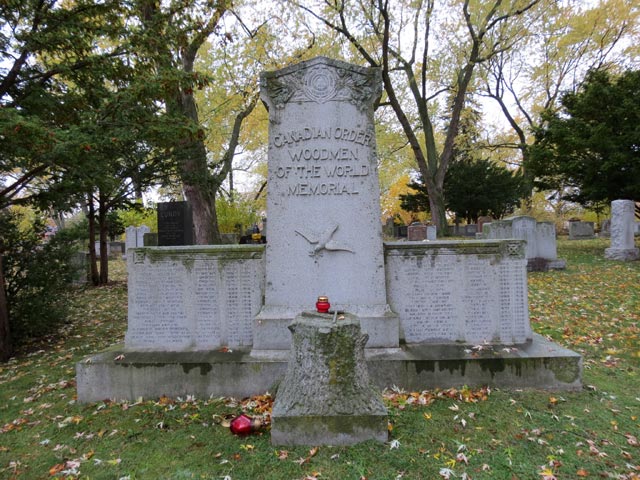Ottawa is home to many cemeteries, each with its own unique story. Ottawa Future will take readers on a journey to these final resting places, sharing the history of the city’s cemeteries and their significance.
Beechwood Cemetery
Beechwood Cemetery is Ottawa’s National Military Cemetery and Police Cemetery, which received its “national” status on March 5, 2009. Many notable Canadian figures rest here, including Ottawa’s Mayor John James Allen and professional hockey player William Stanley Beveridge. It is the largest cemetery in the region, covering an area of 64.7 hectares.
The cemetery’s history dates back to 1873, originally a Protestant cemetery. In the 1870s, soldiers erected a sandstone cairn in honour of Lieutenant-Colonel John Turner. Additionally, a statue of Captain James Forsyth was placed there.
Since 1944, military burials at Beechwood became a regular occurrence, and in 2000, it was designated the National Military Cemetery for the Canadian Armed Forces.
It has been recognized as one of the most significant memorial cemeteries, especially for its neo-Gothic style mausoleum, designed by William Ralston, featuring 546 crypts and bronze doors adorned with Christian symbols. The chapel within is used for cremation services, and the stunning stained-glass windows depicting biblical scenes, designed by James Bloomfield, further enhance the site’s beauty.

Maple Grove Cemetery
Founded in 1875 by a group of six Brooklyn businessmen, Maple Grove Cemetery was established after they purchased 75 acres of undeveloped land from Mary A. Webb.
In the 1830s, the United States grappled with issues of overcrowding and poor sanitation in city cemeteries, prompting the development of rural cemeteries outside urban centres. The first example of this was Mount Auburn Cemetery, created in 1831 in Cambridge, Massachusetts.
Maple Grove Cemetery in Ottawa was founded amidst dense forestland north of Richmond Hill. Over the years, the landscape evolved, featuring a fence, lake, and winding roads. A railway station was later introduced to encourage more visitors, transforming the cemetery into a park-like setting.
In 1876, the “Maple Grove Lodge” was constructed to serve as an office, residence, and waiting room for visitors, as well as a funeral service venue. This historic building became the hub of activity at Maple Grove Cemetery, which was later added to the National Register of Historic Places.
Many notable individuals rest here, including LaVern Baker (Rock & Roll Hall of Fame singer), Melville Ellis (pianist and composer), and Jimmy Rushing (blues singer).

Park Lawn Cemetery
Located in the Etobicoke area of Toronto, Ontario, Park Lawn Cemetery contains over 22,000 graves. Its history began in 1892 as Humbervale Cemetery, and in 1915, it was acquired by Park Lawn, a company that owns five other Toronto cemeteries.
The cemetery has been the target of vandalism twice, in 1990 and 2006, with the perpetrators convicted in court. Despite these incidents, Park Lawn remains a tranquil resting place. The park’s open lawn, mostly shaded by trees, offers a peaceful atmosphere without private crypts but with scenic views of nature.
It is home to the graves of numerous Toronto sports figures, including Conn Smythe and Harold Ballard, as well as musician Jeff Healey.

Metcalfe Union Cemetery
A small cemetery located in the village of Metcalfe, south of Ottawa, the Metcalfe Union Cemetery holds the rich history of pioneering families, including 40 veterans of the Civil War.
As the community grew, the need for a cemetery became apparent. In 1859, just before the Civil War, the “Union Cemetery Society” was formed, and land was purchased for burials. By May 1859, 194 family plots were established, with enough space for 400 graves.
The cemetery became the final resting place for many, including loggers, judges, merchants, and lawyers, with the first burial being that of Anna Douglas in 1859.
The Union Cemetery Association ceased its activities in 1918. However, local volunteers have since worked tirelessly to preserve this historic site. Today, the cemetery is maintained by the Union Historical Cemetery Association, which aims to conserve and restore the grounds for future generations.

Ottawa’s Cemeteries
Ottawa’s many cemeteries are filled with history, each offering a peaceful place for reflection. From celebrities to local residents, these cemeteries are often designed to provide tranquility rather than evoke feelings of fear or sorrow. The serene and well-maintained grounds encourage visitors to reflect on life’s journey, with the promise of peace in the end.
Ottawa’s cemeteries, both within the city and its outskirts, are beautiful locations, offering stunning landscapes and a quiet place to connect with nature and history.